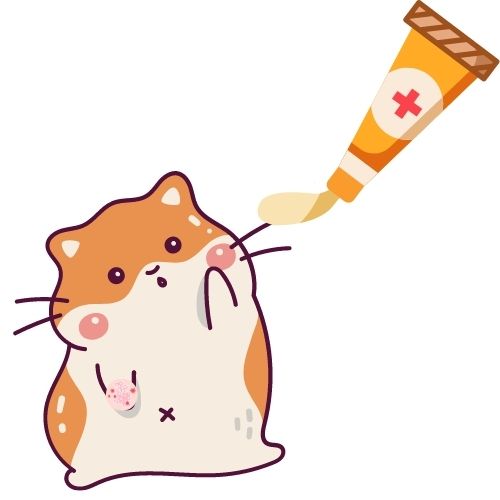We all want our furry friends to stay healthy and happy as they live out their life. However, sometimes they get sick or fall victim to illnesses or other infections, including warts. And if your hamster comes down with warts, the first question you ask if often about the cost of treatment.
Hamster wart treatment can cost anywhere between $15 and $50 depending on the severity of the infection and treatment plan.
But that’s not all there is to know. If your hamster has warts, there’s a lot more to know, including the treatment plan and whether warts are dangerous for small animals.
And that’s what we’re going to cover in the following article. So check out the table of contents below and jump right in to learn more.
First, let’s cover one of the most commonly asked questions: do hamsters get warts?
Do Hamsters Get Warts?
Yes, hamsters can get warts as a result of infection from the papillomavirus.
These warts are small lumps of pus or skin lesions that arise from infection or transmission from other hamsters with warts. Since warts are species specific, you are unlikely to see a human-to-hamster or hamster-to-human transmission of warts.

These growths are generally harmless, painless, and non-cancerous, so there’s not too much concern if you notice your hamster does have a wart, however you should still take steps to have the wart treated and remove if necessary. This is where a veterinarian comes in handy.
Warts generally appear on a hamster’s paws and can be itchy or bothersome, but are otherwise not life threatening. However, you may notice your hamster scratching and biting at the wart, which can lead to further infection, bleeding, and more serious concerns if not treated.
If you notice your hamster has a wart, you should setup an appointment with your vet so the wart can be diagnosed and treated to prevent further injury, pain, or discomfort for your furry friend.
So let’s talk about the treatment for warts.
What is the Treatment for Warts on a Hamster?
If your hamster has warts, while it isn’t life threatening, such as wet tail or other types of infections, you should still seek treatment to avoid it getting worse. As mentioned, your hamster may scratch at the wart, which can lead to worsening complications.
Treatment of a wart generally consists of an injection or application of topical ointment to reduce inflammation. That should eventually cause the wart to reduce in size and disappear within 3 – 5 days.

If the wart is more larger or unaffected by topical ointments, a surgical removal may be necessary, especially if the wart is causing severe pain or discomfort.
Ultimately your veterinarian will make the appropriate call on how to deal with the skin lesion, but it’s important for you to know your options.
You should never attempt to remove, lance, or treat the wart without direction from your vet first as there can be complications rising from unofficial treatments. Not to mention that any ointments made for humans can be harmful to small animals.
Warts generally aren’t serious for your hamster, but let’s talk about when they can be dangerous.
Are Warts Dangerous for a Hamster?
Generally warts aren’t dangerous for a hamster, but if left untreated your hamster may scratch and cause bleeding or other forms of discomfort. As a result, immediate treatment is the best approach.
The other concern is that warts may be a sign of a larger, underlying skin issue that is concerning. And because hamsters are small animals with delicate immune and digestive systems, anything that can eventually turn into a larger issue should be addressed immediately.
Here are a few illnesses that are dangerous for hamsters and should be addressed immediately with a trained veterinarian:
- Wet tail
- Tumors (Hamster tumor removal cost)
- Eye infections
- Diabetes
- Respiratory infections
If you notice your hamster experiencing any of the above, you should take cause to get them looked at as soon as you can. The sooner you can catch an illness developing and get treatment, the more likely your hamster is to survive.
So while warts are generally not too dangerous for your furry friend, you should still take the appropriate steps to get them addressed and resolved.
Frequently Asked Questions
If you still have a few other questions about hamsters and skin lesions, the following questions may be helpful to review before doing another quick Google:

There are many possible reasons why your hamster may develop sores on their body, including a bacterial or fungal infection, allergies, mites or fleas, poor diet, as well as physical trauma. If you notice your hamster having sores, you should immediately consult with a veterinarian.
No, you should not use Neosporin on your hamster because it is not safe for use on small animals. Your hamster may metabolize or ingest some of the ingredients, leading to illness.
No, you should not put hydrogen peroxide on your hamster because it can cause burns and other skin irritations. If your hamster has a cut, there are other ways to treat it without hydrogen peroxide.
Additional Reading
If you’re interested in reading more about hamster health and more, check out the following related articles:
- How to Drain a Cyst on a Hamster – The Pet Property
- Hamster Skin Conditions – First Hamster
- Diseases and Illness of Hamsters – Merck Manual
Conclusion
And there you have it! There is so much to know when you own a hamster that it’s impossible to know everything right from the start, but the health and wellness of your furry friend is paramount.
It’s good to know that warts are generally harmless, but the itching can cause your hamster to scratch and break the skin in that area. So if possible you should get the wart treated as soon as you can at a cost of anywhere between $15 and $50.
And as always, go to a trained veterinarian and never attempt to pierce or treat the wart without direction from a trained professional.